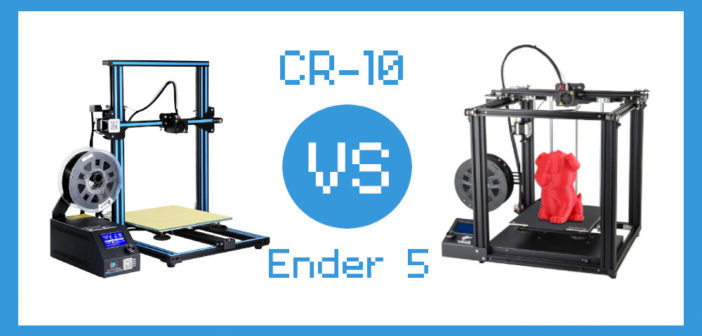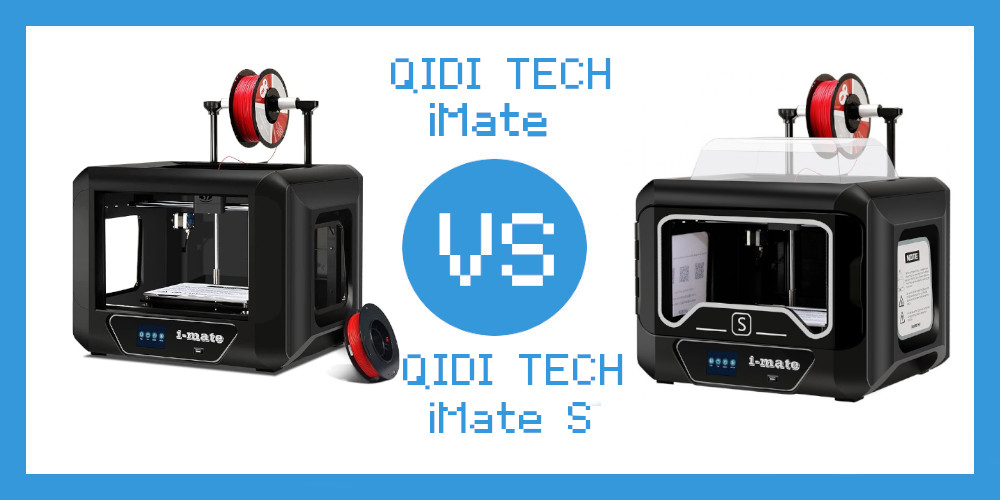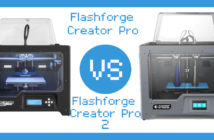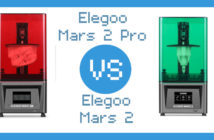Ender 5 vs CR-10 In-Depth Comparison
Coming in at almost the same price, both the Ender 5 and CR-10 are popular choices for DIY makers. If you want a printer to mod and make your own, with the added bonus of a huge build volume, these printers are probably top on your list. But which deserves your hard-earned cash? Today we look at the Ender 5 vs the CR-10 to determine the best large-volume, moddable 3D printer.
Ender 5 Basics
Right away, the Ender 5 differentiates itself from the CR-10 and most other 3D printers. That’s because the Ender 5’s build plate is attached to the Z axis, meaning it moves up and down while the print head moves along the X and Y axes. This requires a cube-like frame which adds overall stability to your prints.
Moving on, the Ender 5 sports a relatively large build volume measuring 8.6”L x 8.6”D x 11.8”H. While that’s not as large as the CR-10’s build volume, it’s still pretty spacious and the printer provides a good square-in-per-dollar ratio. Print with PLA, ABS, TPU, or PETG but skip the exotics unless you invest in some hefty upgrades.
The Ender 5 achieves resolutions from 100-400 microns and is quite speedy, reaching print speeds of 150mm/s and move speeds of 250mm/s. Connectivity options are slim, however, with the Ender 5 offering just an SD port. Like the CR-10, the Ender 5 also uses a super basic turn-knob interface. Click here to read our full Ender 5 review.
CR-10 Basics
Let’s address the obvious: the CR-10 is HUGE. With a 12” x 12” x 15.5” build volume, this CR-10 is one of the absolute best values in large-scale printers. It comes with a heated glass print bed which allows you to print in both PLA and ABS. Notably, the CR-10 uses a bowden extruder, which is not compatible with flexible filaments like TPU. Also, like the Ender 5, the CR-10 hotend maxes out at 260C and includes a PTFE liner, meaning you can’t print with exotic filaments without upgrades.
Beyond its colossal build volume an heated bed, there’s not much to the CR-10. It comes with an extremely simple turn-knob interface, both USB and SD ports, and a solid aluminum frame. Note that the CR-10 requires a bit of light assembly out of the box. Click here to read our full CR-10 review.
Ender 5 vs CR-10 Comparison Similarities: Cost and Construction
Creality has a reputation for creating affordable printers with big specs and both the Ender 5 and CR-10 are shining examples of this. Both come in under $400, which lands them squarely in the “budget” category. Unlike many budget printers, however, you truly feel like you’re getting a great deal with Creality machines. That’s because in addition to offering larger-than-average build volumes, they’re also made with quality components. Both machines feature sturdy, no-nonsense aluminum frames, quality power supplies, and can be modded to your heart’s content.
Ender 5 vs CR-10 Comparison Differences: Build Volume and Filament Compatibility
Simply put, the CR-10’s enormous build volume dwarfs that of the Ender 5. Although the Ender 5 is no slouch, it can’t hold a candle to the CR-10. If you have dreams of printing BIG models in one piece, the CR-10 won’t disappoint. Users also appreciate the large glass print bed for its consistency and longevity as compared to the Ender 5’s flimsier magnetic, removable print bed.
On the other hand, the CR-10 can only handle PLA and ABS. The Ender 5 tackles both PLA and ABS, as well as flexible filaments. While neither include the all-metal hot end required to print exotic filament like Nylon, the Ender 5 effectively doubles your filament options out of the box. That’s significant for those who plan to experiment with different materials.
Ender 5 vs CR-10 Comparison Verdict
This is a tough decision that comes down to your priorities. Both 3D printers have their downsides, but importantly, those issues are relatively easy to fix. For example, upgrading the CR-10 with a direct drive extruder allows it to print with flexible filaments. Similarly, replacing the Ender 5’s metal build plate with a glass one would be a huge overall improvement. In all, both printers are shy of perfection but, depending on your needs, can be fixed to accommodate you.
Overall, if you don’t need the CR-10’s massive build volume, we suggest the Ender 5. It has better stability and better filament compatibility out-of-the-box and is even a bit cheaper. If, however, you want to make extremely large, single-piece models, the CR-10 has you covered. For a bit more than the Ender 5, the CR-10 offers much more space. Think about your priorities before making a decision, but know that both machines are a safe buy.








